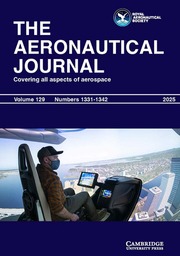Article contents
Two-dimensional viscous flow past flexiblesail sections close to idealincidence
Published online by Cambridge University Press: 04 July 2016
Abstract
A model of the viscous flow past a flexible sailsection operating near the ideal incidence isdescribed. Viscous effects are calculated via weakviscous-inviscid interaction of a panel method andan integral boundary layer method, and a new modelfor the leading edge separation bubble isintroduced. The flexible section is allowed todeform in response to the pressure and shearstresses acting on it. Results are presented for theeffect of incidence, excess length and Reynoldsnumber on the development of the boundary layers oneach side of the section and the consequences forthe lift and drag of the section are described. Thenumerical model is compared with experimentalresults, giving in general good agreement andshedding light on the physics of the viscous flowpast flexible membranes.
Information
- Type
- Research Article
- Information
- Copyright
- Copyright © Royal Aeronautical Society 1995
References
- 8
- Cited by

